Woburn Abbey
| Woburn Abbey | |
| Bedfordshire | |
|---|---|
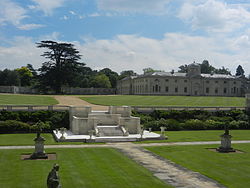
| |
| Location | |
| Grid reference: | SP96483254 |
| Location: | 51°58’59"N, -0°35’48"W |
| Village: | Woburn |
| History | |
| Country house | |
| Information | |
| Owned by: | Duke of Bedford |
Woburn Abbey is the seat of the Duke of Bedford, a grand mansion in Bedfordshire standing to standing the east of the village of Woburn.
Although it is still a family home to the current Duke, Woburn is open on specified days to visitors, along with the diverse estate surrounding it, including the historic landscape gardens and deer park (by Humphry Repton), as well as more recently added attractions including Woburn Safari Park, a miniature railway, garden/visitor centre and a new Center Parcs village.
The name 'Woburn' was until around 1960 pronounced 'wuːbərn,[1] but the apparent pronunciation of the written form has eventually prevailed.
Foundation
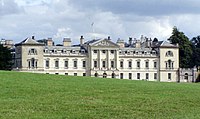
Woburn Abbey, comprising Woburn Park and its buildings, was set out and founded as a Cistercian abbey in 1145.[2] The abbey was dissolved in 1547 as part of the Dissolution of the Monasteries under Henry VIII and the given to John Russell, who became the 1st Earl of Bedford.
The new house built here became the seat of the Russell family, who in time were elevated to become the Dukes of Bedford. The Abbey was largely rebuilt starting in 1744 by the architects Henry Flitcroft and Henry Holland for John Russell, 4th Duke of Bedford.[2] It is said that at Woburn, Anna Maria, the wife of the 7th Duke, originated the tradition and ritual of afternoon tea.[3][4]
In April 1786 John Adams (the future second President of the United States on tour with Thomas Jefferson—who would serve as his vice president before becoming President himself) visited Woburn Abbey and other notable houses in the area. After visiting them he wrote in his diary "Stowe, Hagley, and Blenheim, are superb; Woburn, Caversham, and the Leasowes are beautiful. Wotton is both great and elegant, though neglected".[5] However, in his diary he was also damning about the means used to finance the large estates, and he did not think that the embellishments to the landscape, made by the owners of the great country houses, would suit the more rugged American countryside.[5]
1945 to 1970s
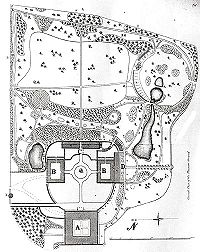
Following the Second World War, dry rot was discovered and half the Abbey was subsequently demolished. When the 12th Duke died in 1953, his son the 13th Duke was exposed to heavy death duties and the Abbey was a half-demolished, half-derelict house. Instead of handing the family estates over to the National Trust, as so many great lords had done in distress, he kept ownership and opened the Abbey to the public for the first time in 1955. It soon gained in popularity as other amusements were added, including Woburn Safari Park on the grounds of the Abbey in 1970. Asked about the unfavourable comments by other aristocrats when he turned the family home into a safari park, the 13th Duke said, "I do not relish the scorn of the peerage, but it is better to be looked down on than overlooked."
1970s to present
The 13th Duke moved to Monte Carlo in 1975.[6] His son Robin, who enjoyed the courtesy title Marquess of Tavistock, ran the Abbey with his wife in his father's absence.
In the early 1990s, the Marquess and The Tussauds Group planned to turn the Abbey into a large theme park with the help of John Wardley, creator of the roller coasters "Nemesis" and "Oblivion". However, Tussauds bought Alton Towers and built one there instead.
From 1999 to 2002, the Marquess and the Marchioness, the former Henrietta Joan Tiarks, were the subjects of the Tiger Aspect Productions reality series Country House in three series, totalling 29 episodes, which aired on BBC Two. It detailed the daily life and the business of running the Abbey.[7] It inspired several storylines for the television series Monarch of the Glen.
The Marquess of Tavistock became the 14th Duke on the death of his father in November 2002 in Santa Fe in the United States. The 14th Duke was the briefest holder of the Dukedom and died in June 2003.
On the death of the 14th Duke, his son Andrew became the 15th Duke, and he continues his father's work in running the Woburn Abbey Estate. The building is listed in the highest category of architecture at Grade I.[8]
Collection
The art collection of the Duke of Bedford is amongst the finest in private hands, and encompasses a wide range of western artwork. The holdings comprise some 250 paintings, including works by Rubens, Van Dyck, Canaletto and Velasquez. Moreover, the collection encompasses examples of the most expensive manufacturers of furniture, French and English in many periods, and a diverse collection of porcelain and silverware.[9]
Paintings
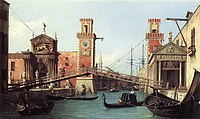
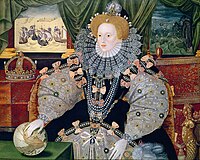
Dutch School
- Asselyn, Jan - 1 painting
- Cuyp, Aelbert Jacobsz - 5 paintings
- Delen, Dirk van - 1 painting
- Flinck, Govert - 1 painting
- Goyen, Jan van - 1 painting
- Potter, Paulus - 2 paintings (A Hawking Party, 1653)
- Rembrandt, Harmenszoon van Rijn - 2 paintings (Boaz and Ruth (paintings)|Boaz, 1643 and Self-portrait, 1640)
- Ruisdael, Jacob van - 2 paintings
- Steen, Jan - 2 paintings
- Velde, Willem van de Velde (the Younger) - 1 painting
- Werff, Adrian van der - 1 painting
English School
- Gainsborough, Thomas - 1 painting
- Gheeraerts, Marcus (the Younger) - 2 paintings
- Hayter, Sir George - 4 paintings
- Hoppner, John - 2 paintings
- Knapton, George - 1 painting
- Landseer, Edwin Henry - 2 paintings
- Reynolds, Joshua - 12 paintings
- George Gower - (The Armada Portrait of Elizabeth I, 1588?, one of the greatest British portraits in existence)
Flemish School
- Critz, John de - 1 painting
- Dyck, Anthony van - 10 paintings (Aubert Lemire, Dean of Antwerp, c. 1630)
- Eworth, Hans - 1 painting
French School
- Bercham, Nicholas - 1 painting
- Lorrain, Claude (known as Claude Gellée) - 2 paintings
- Lefebvre, Claude - 1 painting
- Loo, Carl van - 1 painting (Portrait of Louis XV)
- Poussin, Nicolas - 2 paintings
- Vernet, Claude Joseph - 2 paintings
German School
- Holbein, Hans (the Younger) - 1 painting
Italian School
- Batoni, Pompeo - 1 painting
- Canaletto - 24 paintings (View of the Entrance to the Venetian Arsenal, c. 1732 - one of Canaletto's greatest works)
- Ricci, Sebastiano - 1 painting
- Salvi, Giovanni (Il Sassoferrato) - 2 paintings
Spanish School
- Murillo, Bartolomé Esteban - 1 painting
- Velázquez, Diego - 1 painting (Portrait of Admiral Pulido Peraja, Captain General of the Armada Fleet of New Spain)
On film and television
The Abbey has been a frequent location for filming, including:
- A Lizard in a Woman's Skin (1970)
- Coronation Street (television soap, 1973 episode), which featured a cameo by the 13th Duke[10]
- Five Clues to Fortune (alias The Treasure at Woburn Abbey) (1957, Children's Film Foundation)
- The Iron Maiden (1962)
- The Flower of Gloster (1967)
Outside links
| ("Wikimedia Commons" has material about Woburn Abbey) |
- Woburn Abbey
- The Woburn Abbey Collection of Classical Antiquities in the 'Arachne' archaeological database
- http://www.mspong.org/picturesque/woburn_abbey.html
References
- ↑ "Woburn Abbey". Collins Dictionary. n.d.. http://www.collinsdictionary.com/dictionary/english/woburn-abbey?showCookiePolicy=true. Retrieved 23 September 2014.
- ↑ 2.0 2.1 Chisholm 1911, Woburn, England.
- ↑ Woburn Abbey: Food and Drink
- ↑ http://www.britannica.com/EBchecked/topic/646393/Woburn-Abbey
- ↑ 5.0 5.1 Adams & Adams 1851, p. 394.
- ↑ "The Duchess of Bedford" by Nicole Nobody
- ↑ [1]
- ↑ Woburn Abbey - Grade I National Heritage List 1114006: Woburn Abbey
- ↑ Woburn Abbey (Park and Garden) - Grade I - National Heritage List 1000364: Woburn Abbey
- ↑ Coronation Street
- Adams, John; Adams, Charles Francis (1851). The Works of John Adams, Second President of the United States: Autobiography, continued. Diary. Essays and controversial papers of the Revolution. The Works of John Adams, Second President of the United States. 3. Little, Brown,. p. 394.
Books
- Angelicoussis, Elizabeth (1992). The Woburn Abbey Collection of Classical Antiquities, Monumenta Artis Romanae XX. Zabern. ISBN 978-3-8053-1303-2.
